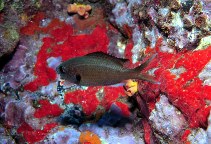| Family: |
Pomacentridae (Damselfishes), subfamily: Chrominae |
| Max. size: |
20 cm TL (male/unsexed) |
| Environment: |
reef-associated; marine; depth range 0 - 60 m, non-migratory |
| Distribution: |
Western Atlantic: Florida and Texas (USA) and throughout the Caribbean Sea to Brazil (Ref. 9626, 35834). Eastern Atlantic: St. Helena and Ascension islands and from São Tomé. |
| Diagnosis: |
Dorsal spines (total): 12-12; Dorsal soft rays (total): 12-13; Anal spines: 2-2; Anal soft rays: 11-13. A prominent black spot at the pectoral-fin base, and a white spot just behind the posterior base of the soft dorsal fin (Ref. 7247). Grayish brown on back, shading to silvery gray on sides; dorsal fin broadly edged with bright yellow; upper and lower edges of caudal fin narrowly yellow with a submarginal dark band (Ref. 13442). |
| Biology: |
Adults generally occur in steep slopes and patch reefs. Diurnal species (Ref. 9626), they most commonly form moderate-sized feeding-schools over reef tops, rising above the bottom to feed on plankton, mainly copepods. Often seen with Chromis cyanea (Ref. 9710). Oviparous, distinct pairing during breeding (Ref. 205). Eggs are demersal and adhere to the substrate (Ref. 205). Males guard and aerate the eggs (Ref. 205). Rarely marketed (Ref. 3139). |
| IUCN Red List Status: |
Least Concern (LC); Date assessed: 15 November 2010 Ref. (130435)
|
| Threat to humans: |
harmless |
Source and more info: www.fishbase.org. For personal, classroom, and other internal use only. Not for publication.

